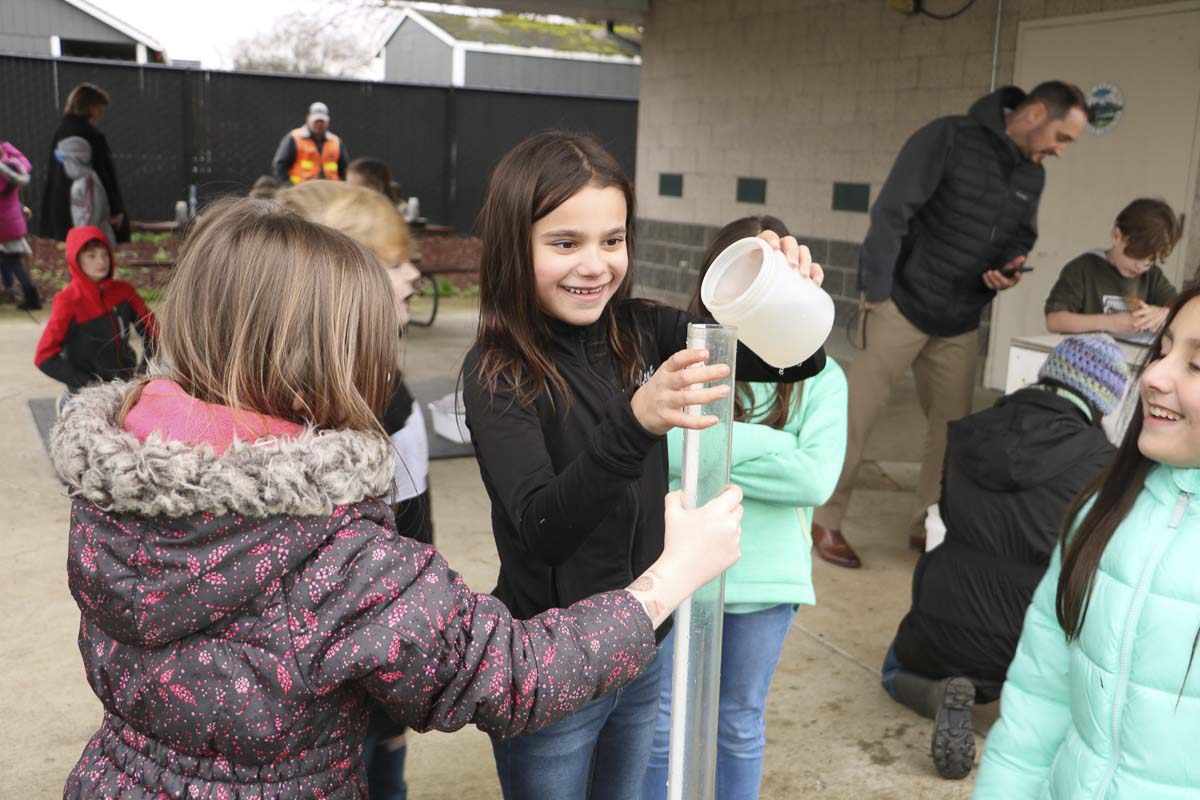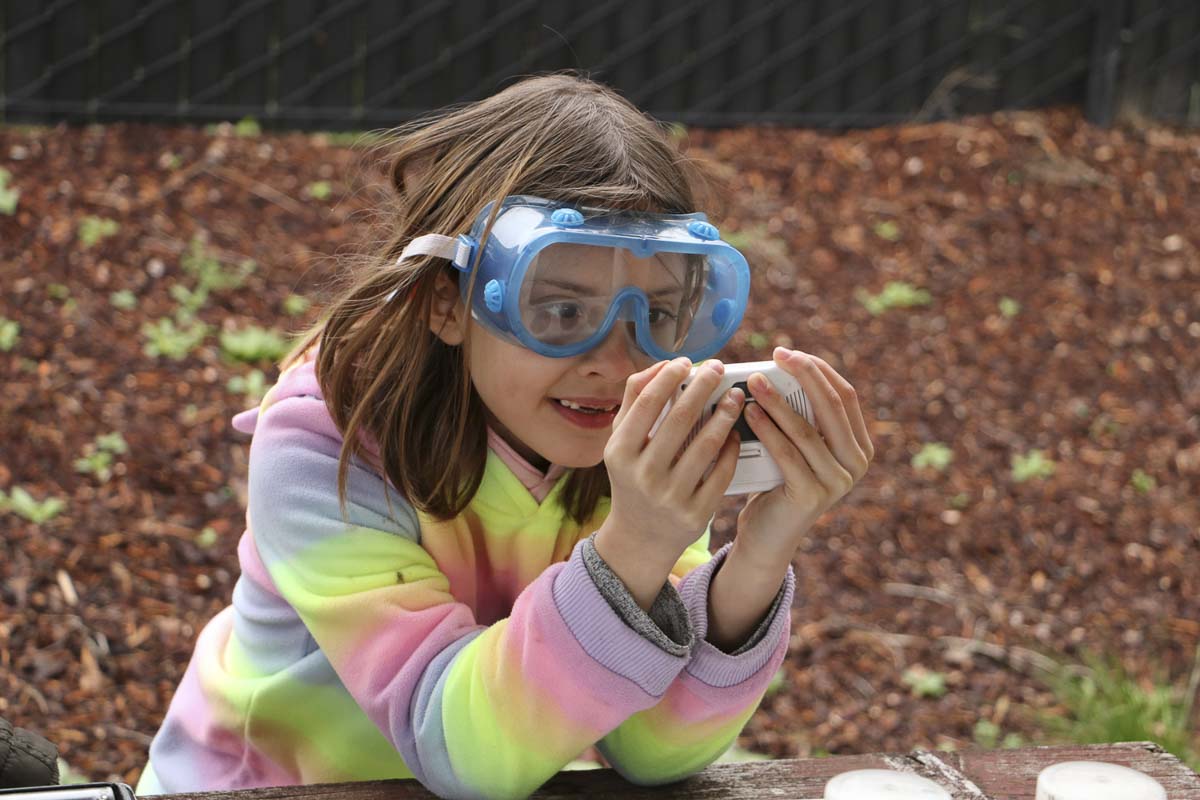These young scientists are just some of the more than 3,000 Clark County students who make up the Student Watershed Monitoring Network
BATTLE GROUND — Patricia Harmon’s third grade students at Maple Grove Primary School take their roles as scientists very seriously. Donning protective goggles, a group of students is seated around a picnic table testing water samples, carefully recording the data they collect along the way.

Nearby, another group of four students is huddled over a small plastic tub filled with water and a few aquatic plants, using pipettes and plastic spoons to check for tiny critters. Suddenly there’s a breakthrough, as an excited voice exclaims “Ms. Harmon, I found a stonefly!”
These young scientists are just some of the more than 3,000 Clark County students who make up the Student Watershed Monitoring Network (SWMN). Supported by Clark County’s Clean Water Division and the City of Vancouver’s Water Resources Education Center, the project trains teachers and students in grades kindergarten through high school to monitor water quality and habitat in a local stream, lake, river or wetlands.
“These students are learning standardized procedures used to collect and interpret data,” said Rainy Rau, water educator from the Water Resources Education Center. “The work they’re doing for this project aligns with level one science from the State of Washington’s Next Generation Science Standards. If problems with a body of water are discovered during the course of student data collection, qualified professionals are alerted for follow-up response to the issues. So the students have a real impact.”
To collect their data, the Maple Grove students only need to walk a few hundred feet from their classroom to a pond just northeast of their campus where they’re greeted by Maria Tunno, a part-time watershed educator assisting the city of Vancouver and Clark County with the SWMN, and Chad Schwatka, the stormwater program coordinator with the city of Battle Ground.
Tunno and Schwatka are there to help introduce the class to the local watershed and train them to take in-the-field water measurements. The tests include sampling the stream flow, water temperature, pH, phosphates, dissolved oxygen, and turbidity levels. Turbidity is a measure of the degree to which the water loses its transparency due to the presence of suspended particulates. The more total suspended solids in the water, the murkier it seems and the higher the turbidity.
Building on these skills, the students learn to collect and evaluate species of macroinvertebrates present in the waterway. Macroinvertebrates are organisms that lack a spine, but are large enough to be seen by the naked eye. Because different types of macroinvertebrates tolerate different stream conditions and levels of pollution, their presence or absence is used to indicate clean or polluted water.

For example, most larvae of caddisflies, mayflies, and stoneflies cannot survive in polluted water, so streams with these bugs are assumed to have good water quality. However, the absence of these organisms in a body of water does not necessarily indicate that the water quality is poor. Other natural factors, such as temperature and flow, also come into play.
“It has been a pleasure working with Maple Grove and River HomeLink students on this project for the last five years, and we hope that through multiple years of sampling, students can begin to think about how their everyday activities influence the quality of surface waters within their environments,” Schwatka said. “It’s a joy to see students in the outdoors while they’re learning, and we are pleased that we have the opportunity to expose kids to their local watersheds. The program is also great for the city of Battle Ground, as it helps fulfill state requirements. But more importantly, it provides opportunities for us to directly educate and connect with the community we serve.”
In the past, students from Battle Ground Public Schools have collected water quality data from Woodin Creek and its tributary waters. Woodin Creek is one of the larger creeks that run through the city of Battle Ground, joining downstream with Salmon Creek just outside of city limits.
“It’s very rewarding watching young students discover things that excite them in a scientific setting,” Tunno said. “Getting outside provides an opportunity for kids to connect with nature and realize that they can have an impact on protecting and preserving the world around them. It can be quite empowering for kids to experience observational learning like this.”
Students and classes that obtain water quality data throughout the school year are invited to present their overall conclusions to other students and professionals from southwest Washington at a conference called Watershed Congress. Hosted in May of each year by the Vancouver Water Resources Education Center and Clark County Public Works, Watershed Congress has proven to be a great way to keep students engaged while exposing them to real-world communications and presentation experience.
“This is such exciting work for these young scientists,” said teacher Patricia Harmon. “My class is always eager to get outside to work on this project, and it’s amazing seeing them so engaged with the subject matter.”
Information provided by Battle Ground Public Schools.




